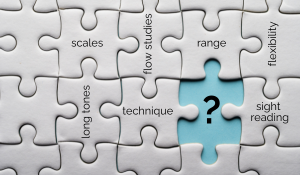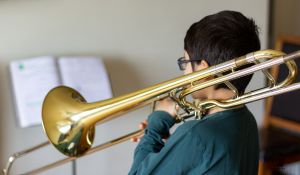Scales and Long Tones are Useless Without This Skill

 As a professional musician, there is no shortage of things to practice. We have scales, flexibility, sound production, range, articulation, technique, extended technique, etudes, excerpts, solo repertoire, improvisation, ii-V-Is, and on, and on, and on! Sometimes this list can feel overwhelming and like there is never enough time to get everything done.
As a professional musician, there is no shortage of things to practice. We have scales, flexibility, sound production, range, articulation, technique, extended technique, etudes, excerpts, solo repertoire, improvisation, ii-V-Is, and on, and on, and on! Sometimes this list can feel overwhelming and like there is never enough time to get everything done.
Unfortunately, I must add one more thing to the list – possibly one of the most important, but often overlooked elements of music: Intonation.
It doesn’t matter how fast you can play, or how high. If what you are playing is not in tune, no one will want to hear it. Luckily, working on intonation can be combined with many of the other elements listed above to save time and create efficiency. The following are some easy ways to incorporate intonation practice into your fundamentals practice session.
The First step is to make sure that you have a chord tuning chart. A quick google search should provide a suitable chart with explanations of the system. This will help you to know how to adjust each note. Additionally, a complete overtones chart for your instrument so that you know what alternate fingers or positions might be applicable to avoid making adjustments with the embouchure. Trumpet players can find both of these and more in my book Trumpet and the Rule of Three available from Art of Sound Music.
Get our newest tips, updates, videos, clinics, community events, and more by joining Denis Wick Tips Blog
Long-tones: An easy way to add an intonation element to your practice is play your long-tones with a drone pitch. There are many ways to add a drone to your session including “cello drones” on YouTube and the Tonal Energy app. You can play in unison with the drone, as well as other intervals. Working on long-tones with a drone is very helpful for learning how each interval should sound – be sure to use a tuner, such as the one found in the Tonal Energy app, that can be set just-intonation in each key.
Scales: Another way to add intonation work to your practice is to play your scales with a drone. I have two different approaches to this type of practice. In the first, I pick a key and work through as many scales as I can. Never move from a note until it is in-tune and take as much time as you need. Each day, pick another key. The second approach is mostly applicable once you feel comfortable in all the keys. I start in C and set my drone to move up a half-step every two minutes. This gets me through all the keys in just 24 minutes. During those two minutes, I play through different scales and arpeggios making sure that each note is in tune.
Pro-tip: If the device that you are using to play the drone isn’t loud enough while you are playing, using earbuds can be very helpful. Put one earbud in, to clearly hear the drone pitch, and one out so that you can also clearly hear yourself. This approach is very helpful because when the notes are out of tune, it is very easy to tell.
Good luck and happy music making!

Find all our Denis Wick resources in one spot on the Denis Wick app. Download to view videos, clinics, educator resources, podcasts, product information & more!




